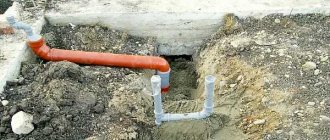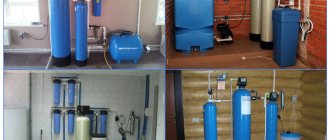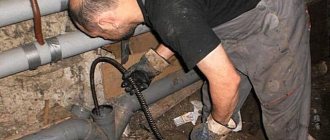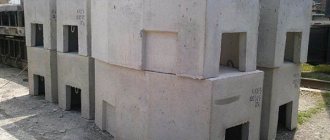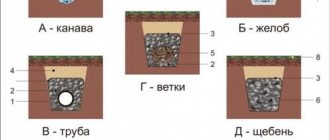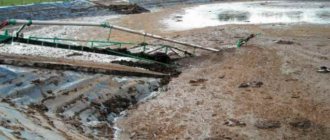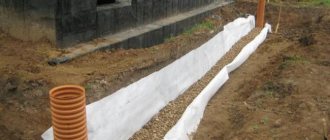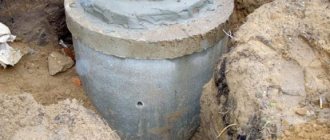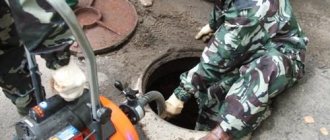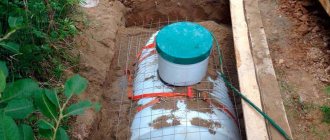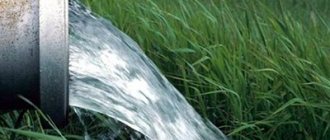The road-style design keeps large debris out, preventing clogging, and supports the weight of vehicles.
Why do you need a rainwater inlet made of reinforced concrete, and what other types of materials are used for closed storm drains? And in general, what types of rainwater drainage systems exist today? We will now look for answers to these and other questions.
Construction of a well for storm drainage
Let's look at the design principle of this system and how it works. Since the well is designed to collect water and transport it for further use, for example, watering a site, there are several options:
- Inspection well. It will be needed for a large length of pipes along the site, as well as if pipes from several places converge into it.
- Perpadny well. Used on steep slopes.
- Turning. To change the direction of drains.
- Absorption well with drainage. To drain the area.
- Cumulative. This is a reservoir where water from the entire area is collected, and it can be used for the necessary purposes.
The number of wells along the route may vary. It all depends on the topography of the site, the amount of water when snow melts, soil and other factors. You can get by with a minimum of structures. How many wells are needed and how best to build a storm drainage system, the professionals will tell you.
Option for storm drainage scheme Source gidkanal.ru
Which drainage well to choose: varieties
A drainage well is an element of the drainage system, designed for its normal functioning, as well as monitoring and cleaning drainage pipes. In the presence of water-absorbing soils, it is used as a filter and absorption well. Or (if the soil has weak water absorption) serves as a water intake. Based on this definition, drainage wells can be divided into the following types:
- Rotary and viewing;
- Absorption (filtering);
- Water intake (storage).
Let's look at each type in more detail.
Rotary wells are installed in places where drains (drainage pipes) turn. This could be the corner of the foundation, elevation changes, the convergence of several drains, or places most prone to blockages. Through the inspection well for drainage, visual inspection and subsequent access for cleaning the drains are carried out. Both are equipped with a sealed bottom and lid.
The size of the wells is selected in such a way that, if necessary, it is possible to flush the drainage system with water pressure under pressure. The diameter of such devices is ≈ from 300 to 500 mm. If it is assumed that a person must go down into the drainage well to access the system, then the diameter increases to 1 meter or more.
Inspection wells are installed in places where drains turn, when the slope changes and when there are differences in heights.
The optimal distance between inspection wells on straight sections is 40 meters, the maximum distance is 50 meters. When turning drains at the ledges of buildings, a manhole need not be made if the distance from the turn to the nearest manhole in the structure is no more than 20 meters. If the drainage pipes make several turns in the area between the inspection wells, then they are installed after 1 turn.
The choice of filter (absorption) well is determined by the type of soil on the site. The purpose of this structure is clear from the name - the water entering it from drains is collected in a receiver, filtered (through a layer of crushed stone, etc.) and through special holes or, if the well does not have a bottom, goes into the underlying layers of soil. Those. the soil must have sufficient water absorption capacity to cope with the volume of water entering the well. Such soil can be coarse sand. Otherwise, if there is an aquifer, the water entering the well will not be able to go into the soil, and over time it will overflow.
Storage sealed wells are used in areas with high groundwater level, clay soil and soil that does not have high water absorption capacity. And also in areas with deep water intake layers, it is not economically profitable to drill down to them and arrange vertical drainage.
Such a well is the final reservoir of the drainage system.
As it arrives, the collected water is pumped out by a drainage pump and discharged beyond the border of the site into a nearby ditch or used for irrigation.
Therefore, before building a drainage, it is necessary to carry out a hydrogeological study of the soil and determine its composition and ability to absorb water. Without this data, drainage construction is blind construction, without understanding the essence of the processes occurring in the soil.
Alex_UUUUser FORUMHOUSE
In my opinion, before calculating and building drainage, you need to find out what kind of soil you have and find out how much water you will need to drain. It’s one thing if the site has a high ground level and clay, and a completely different matter if the ground level is low and the soil is sand.
sevenstreamsUser FORUMHOUSE
You should not think that the larger the volume of the drainage well and the deeper it is, the better. Any volume (at least 10 rings), if the water has nowhere to “go”, will fill up very quickly. And vice versa - you can bury two rings under the drainage well and drain water from it by gravity or with a pump, and the drainage will work.
The simplest way to “by eye” check the soil’s ability to absorb water is to dig a shallow hole in the area with your hands and a shovel, pour water into it and see how quickly it goes away. If the water drains slowly or does not drain at all, you should think about where it will go if you build a filter drainage well. An attempt to “dig” to the drainage layer, without knowledge of the geology of a particular area, may be doomed to failure.
Jgaz66FORUMHOUSE user
It was necessary to make drainage on a difficult site for a heavy house. High water, dirt road, slope of 11 degrees - a full range of difficulties. They thought about making a vertical drainage and drilling a well to the rubble. This is approximately 30 meters. It would be necessary to install casing pipes, filters, backfill with granite crushed stone, etc. In total, after calculation it turned out that it was necessary to drill 3 wells per 20 linear meters. And... the customer eventually refused such drainage. Too expensive.
Moreover, the water on the site (runoff) can be completely different, with different levels of occurrence. This is surface water - stormwater, derived from snowmelt and rain, perennial water - one of the types of groundwater, etc. Those. Drainage is not just about draining water. You need to know what kind of water you need to divert.
Types of storm wells
Wells for storm sewers consist of the same materials and have the same type of device. Storm drains may differ in the type of sewer system:
- Closed.
- Mixed.
- Open.
Closed storm sewer Source pogreb-podval.ru
Open wells for storm sewer look like gutters through which water flows. Closed storm water inlets collect moisture through pipes underground, after which they are drained or sent for treatment. A mixed type of storm drain may contain arched channels and closed pipe systems, but ultimately the water still ends up in a storage tank, where it can be used in the future. The end well for a storm drain must be sealed to prevent the accumulation of debris.
Features of a plastic rainwater inlet
Plastic wells are a new type of model, used quite often in private summer cottages. For their manufacture, special plastic is used, which is able to withstand temperature changes and is resistant to chemicals that are mainly present in the soil.
Advantages:
- The surface of the plastic rain inlet is smooth, which allows water to easily flow into the drainage system. Layered deposits do not form on the walls of the well, which increases service life.
- The strength of PVC is not inferior to either metal or concrete. Therefore, their service life is unlimited and does not require constant maintenance.
- Plastic storm water inlets are resistant to low frost temperatures and can withstand the harshest winters.
- 100% environmentally friendly. During temperature changes and high humidity, the Material does not release harmful components into the environment.
- Easy to install and light weight, does not require additional waterproofing
- You can increase the throughput by connecting several wells.
The most popular materials for the production of plastic rainwater inlets are polymer concrete and polypropylene, which have good thermal insulation and protection characteristics from the negative effects of moisture. It was the technical features of the material and the low price that made plastic receivers very popular in summer cottages.
High strength PVC structures, Nyloplast structures are an exceptional choice for heavy and bulky concrete manholes. Storm drains, curb entrances and built-in gutters are easily installed with minimal equipment and labor. Capable of handling loads, plastic structures provide a watertight seal with excellent savings.
Drainage well: plastic, concrete
Most often, wells are made of two types of materials: concrete and plastic. You can order any for installation. Let's look at the advantages and disadvantages of each.
Features of drainage wells made of concrete rings
The concrete storm drainage well is quite strong. It consists of a concrete slab and a ring. This material is not expensive, but it will require lifting equipment. In addition, concrete is a fairly durable material, but it is destroyed by water over time. The prefabricated structure is quite difficult to install; it is especially difficult to drill holes in the pipeline. In addition, it is necessary to ensure high-quality waterproofing. However, by calling the experts, you can install a concrete structure without difficulty.
Drainage well made of concrete rings Source strojdvor.ru
How to install?
The process is similar to installing trays:
1. Preparing the excavation. It is carried out manually or mechanically. The depth is determined in accordance with the design documentation and taking into account the fact that upon completion of installation the grating should be 3 mm below the road surface.
2. Laying the base of the frame from concrete mortar. A leveling layer of dry sand-cement mixture is laid (if required by the project), the thickness of which must be at least 50 mm.
3. Installation of a point water collector. After laying the concrete, the lower section of the rain inlet (rain well) is installed with pre-cut holes for the pipe (in those places where it is necessary). Next, other parts are mounted (if the structure consists of several sections).
4. Pipe connections;
5. Completion of the formation of the concrete frame using formwork. And after that - filling the seams connecting the rainwater inlets with the roadway. When installing, it is necessary to provide additional sealing of the joints of the technological seam between the artificial turf and the wall of the concrete enclosure
6. Installation of the grille.
Standardpark specialists will be happy to help with the selection and answer all questions, and are even ready to make a surface drainage project for your site. Contact us!
Storm drainage system
When laying a concrete ring or polymer chamber, a sand and gravel cushion is created. If the well is sealed, a concrete slab is laid under it and everything is coated with bitumen. Or the drainage pad is made thicker. Even at peak loads, the storm drain must cope with the flow of water, so grates and sand traps are needed. The drop well will take the brunt of the water, so a metal sheet is needed there. This will prevent the body from collapsing.
If a plastic system is preferred, it installs faster. When installing 2-3 wells, you can choose plastic, although concrete rings help save on purchases. However, the savings are outweighed by the light weight of the plastic and ease of maintenance. It is up to the customer to decide which material to choose.
Softrock drainage system: what you should know when choosing
Every owner of a garden or summer cottage, without exception, dreams of having fruit trees growing on his territory and not having problems with waterlogging of the soil. Today this can be achieved with the ready-to-install, innovative Softrock drainage system. What attracts attention? Firstly, high operational efficiency, secondly, ease of installation and quality of work.
Anyone can take advantage of lucrative offers at any time. The website presents current and necessary products and information for them. The Softrock drainage system is perfect for inserting into any type of selected well. Be confident in the quality and practicality of the products. Installation of devices will not take much time and effort. If you have any questions regarding the drainage system, its advantages and application features, please contact the company’s experienced specialists. Call the phone number +7 499 - 647-40-37 (Moscow), professionals will definitely answer.
Stages and nuances of well installation
Inspection and drainage wells will be the basis of the stormwater system. It is very important to correctly calculate and install them, otherwise during operation the soil will be washed away or blockages will appear. Be sure to entrust the calculation, design and installation of storm drainage to professionals to avoid the appearance of puddles on the site.
Let's look at an example of installing a plastic structure. For this you will need:
- Corrugated pipe.
- Plastic bottom.
- Sealing rubber.
The choice of high-quality components is the key to an excellent design Source servisnab.com
The volume of the well can be any, depending on the landscape and the flow of liquid. The inspection well is the largest in volume, and the rotary and storage well is slightly smaller. A concrete anchor is attached to each well. So that when the soil swells after winter, the structure does not squeeze out.
All parts are very light, and in this case special equipment is not needed, which means installation will be carried out quickly and without problems. Plastic wells will be placed along the perimeter of the site in the right places according to a previously created stormwater design. After which the trenches are buried, and only point elements of the structure are visible.
Installation of equipment
Drainage for a septic tank can be done like this:
- — Digging a hole;
- — Arrangement of the pit. Lay the brick along the walls, leaving small holes for perforation and gaps where there is no mortar. This allows the system to remove liquid through the walls;
- — Connection of a drainage well with a septic tank through a pipe
- — Putting into operation.
A simpler drainage system for a septic tank is constructed from a reinforced concrete ring without a bottom. Holes for water are punched, a hose is connected and the installation is ready for operation.
And a very simple and familiar way of arranging a drainage well is to install a large plastic barrel with holes for water into the hole. The bottom of the barrel can be weighted with fine gravel and sand. In addition to stability, such a weighting agent will help purify the liquid and retain sediment.
Why is a storm drain well useful?
Storm sewer wells can be used not only to collect liquid from melting snow and rain, but also to collect and remove tap water and sewage from the house. But experts do not recommend combining a storm drain with a house sewer or septic tank, since the treatment facility may overflow and fail. Untreated wastewater can end up in the ground. It is necessary to draw separate conclusions and additional wells. This will help not only not to pollute the area with unnecessary waste, but also to filter the water and reuse it, if desired, for irrigation.
Using collected water for irrigation is profitable and environmentally friendly
Installation of absorption drainage wells
Absorbing drainage wells differ from storage wells by the absence of a bottom in its classical sense. Instead of a bottom, a drainage layer of sand and crushed stone is installed at the bottom of the well to drain the incoming water into the ground. This option is only possible in soils with good water conductivity. In dense clay soils, water will stagnate, which can lead to an emergency.
It should be taken into account that the absorption model of the drainage well is demanding in terms of installation depth. The drainage part must be located lower than the soil freezing line. This is necessary to ensure that the drainage mixture does not freeze or freeze. If it freezes, its capacity will be impaired and the well will cease to perform its functions.
Technology for constructing an absorption-type drainage well: • a drainage well capacity is installed on a cushion of crushed stone at the bottom (at least 2-3 dm); • a similar layer of drainage mixture is also poured inside the container; • connect drainage communications; • the space between the walls of the well and the pit is filled with sand and crushed stone; • the structure is compacted from above with soil removed when digging a pit.
Such wells are suitable for houses with a low level of peak water discharge due to the low absorption rate.
